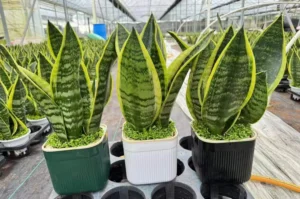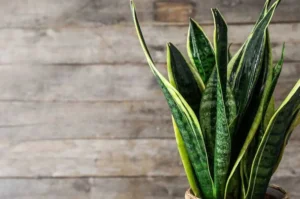The snake plant, also known as Sansevieria or Dracaena trifasciata, is one of the most popular houseplants in the world today. With its upright, sword-shaped leaves and hardiness, it’s often found in modern homes, offices, and gardens. But behind this trendy plant lies a rich history that stretches back centuries, from dry African landscapes to becoming a beloved indoor staple.
In this article, we’ll explore the fascinating journey of the snake plant, tracing its roots from native African regions to homes around the world.
Origins in Africa: A Tough Survivor
The snake plant is native to West Africa, particularly regions such as Nigeria, Congo, and Tanzania. These areas have hot, dry climates with limited rainfall — an environment where only the toughest plants survive. The snake plant evolved to thrive under these conditions, developing thick, waxy leaves that store water, allowing it to endure long periods of drought.
In its native habitat, the snake plant grows in rocky and sandy soils. Its ability to grow with minimal water made it an ideal plant for harsh environments
Traditional Uses in African Cultures
Long before it became a houseplant, the snake plant held cultural and practical value for African communities. It was used in various ways:
- Fiber production: Some species of Sansevieria were used to make strong ropes and baskets due to the tough fibers found in the leaves.
- Medicinal uses: In traditional medicine, parts of the plant were sometimes used to treat ailments like skin infections, snake bites, and wounds.
- Spiritual symbolism: The plant was believed to have protective powers, and some communities planted it near homes to ward off evil spirits or negative energy.
These traditional uses gave the snake plant more than just aesthetic value, it had spiritual and functional significance in daily life.
Discovery and Introduction to the Western World
During the 18th and 19th centuries, European explorers and botanists traveled through Africa and brought back exotic plant species to their home countries. The snake plant was among them. It was officially classified by Carl Peter Thunberg, a student of the famous Swedish botanist Carl Linnaeus, in the late 1700s. Thunberg named the plant Sansevieria trifasciata after the Italian prince of San Severo.
With its unusual shape and low-maintenance nature, the plant gained popularity in Europe as an ornamental indoor plant.
The Rise of the Snake Plant in Modern Homes
By the mid-20th century, the snake plant was being cultivated in nurseries across Europe, North America, and Asia. Its popularity skyrocketed during the 1950s and 60s when homeowners embraced modern and minimalist interior styles. The snake plant’s architectural form and sculptural look make it a perfect fit for contemporary spaces.
It was especially praised for:
- Air purification: NASA’s Clean Air Study in the 1980s listed the snake plant as one of the top air-purifying indoor plants. It removes toxins such as formaldehyde, benzene, and xylene.
- Low maintenance: It doesn’t need frequent watering and can thrive in low light, making it ideal for busy lifestyles.
- Adaptability: Whether on a windowsill or in a dark hallway, the snake plant can adjust and flourish.
Botanical Reclassification: From Sansevieria to Dracaena
In recent years, botanists have made a change to how the snake plant is classified. Originally placed in the Sansevieria genus, it has now been reclassified under the Dracaena genus due to genetic similarities. This means its scientific name is now Dracaena trifasciata, although most plant lovers still use the traditional name Sansevieria.
This reclassification hasn’t affected the plant’s popularity — if anything, interest has grown due to increased awareness about indoor plant care and decor.
Global Popularity and Modern Symbolism
Today, the snake plant is a global phenomenon. It’s loved by urban gardeners, plant enthusiasts, and interior designers alike. In places like China and Japan, the plant is associated with good fortune and is often gifted during festivals or housewarming ceremonies.
In Feng Shui, it is said to bring strong protective energy, and in many cultures, it symbolizes resilience, growth, and clean energy.
Why It Belongs in Every Home
The snake plant’s long journey from the African savannas to urban apartments around the world shows how nature and culture can come together beautifully. It’s not just a houseplant; it’s a piece of living history that:
- Improves air quality
- Adds style to your space
- Requires minimal care
- Holds rich cultural significance
No wonder it’s a favorite among beginners and seasoned plant parents alike!
Frequently Asked Questions (FAQs)
Is the snake plant really from Africa?
Yes, the snake plant is native to parts of West Africa, particularly Nigeria and surrounding regions.
Why is it called a “snake plant”?
It gets its name from the serpent-like appearance of its upright, patterned leaves, which resemble snake skin.
What are other common names for the snake plant?
It’s also known as Mother-in-Law’s Tongue, Viper’s Bowstring Hemp, and Sansevieria.
Can I grow a snake plant in a low-light room?
Absolutely. Snake plants can tolerate low light, although they also enjoy bright, indirect sunlight.
Conclusion
The snake plant is more than just a trendy houseplant — it’s a survivor, a purifier, and a symbol of history and culture. From its rugged beginnings in the arid African lands to becoming a staple of indoor living, the snake plant’s journey is a remarkable one. Its hardiness, elegance, and usefulness have helped it win the hearts of people across generations and continents.
So the next time you water your snake plant or admire its bold green leaves, remember that you’re caring for a plant with a legacy rooted deep in the soil of time.






